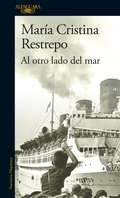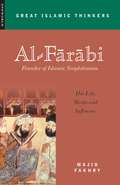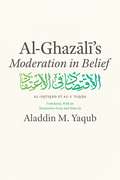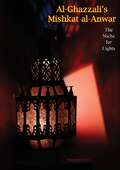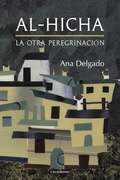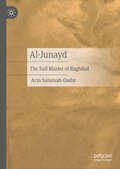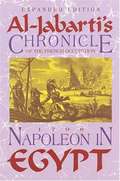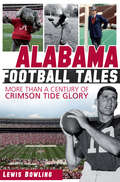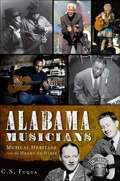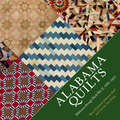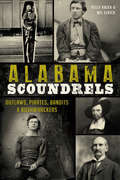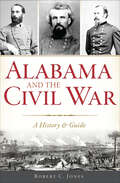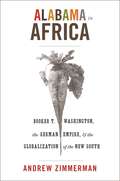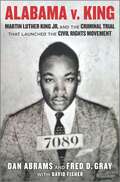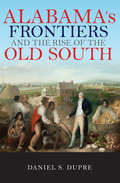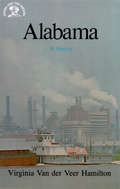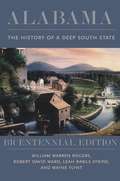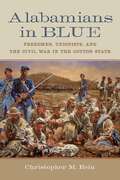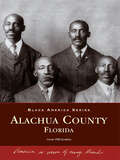- Table View
- List View
Al otro lado del mar
by María Cristina Restrepo<P>Una novela que cuenta la historia de una pareja alemana en Colombia antes de la llegada inminente de la segunda guerra mundial. <P>Al otro lado del mar es la historia de Albert y Honorine, una pareja de alemanes que disfrutaban de su tranquila vida en Cartagena de Indias hasta que fueron deportados debido al temor y la desconfianza que se generaron alrededor de los alemanes en los años previos a la Segunda Guerra Mundial en Colombia. <P><P>En esta apasionante y conmovedora narración, María Cristina Restrepo revela un mundo en guerra, una familia que debe luchar por sobrevivir y una realidad desconocida sobre los inmigrantes alemanes en Colombia en esa convulsionada época.
Al-Farabi, Founder of Islamic Neoplatonism: His Life, Works and Influence (Great Islamic Thinkers Ser.)
by Majid FakhryThis is the only available comprehensive introduction to the life and achievements of the ninth-century Islamic pjilosopher, Al-Farabi.
Al-Ghazali's "Moderation in Belief": Al-Iqti?ad Fi Al-I ' Tiqad
by Al-GhazaliCenturies after his death, al-Ghazali remains one of the most influential figures of the Islamic intellectual tradition. Although he is best known for his Incoherence of the Philosophers, Moderation in Belief is his most profound work of philosophical theology. In it, he offers what scholars consider to be the best defense of the Ash'arite school of Islamic theology that gained acceptance within orthodox Sunni theology in the twelfth century, though he also diverges from Ash'arism with his more rationalist approach to the Quran. Together with The Incoherence of the Philosophers, Moderation in Belief informs many subsequent theological debates, and its influence extends beyond the Islamic tradition, informing broader questions within Western philosophical and theological thought. The first complete English-language edition of Moderation in Belief, this new annotated translation by Aladdin M. Yaqub draws on the most esteemed critical editions of the Arabic texts and offers detailed commentary that analyzes and reconstructs the arguments found in the work’s four treatises. Explanations of the historical and intellectual background of the texts also enable readers with a limited knowledge of classical Arabic to fully explore al-Ghazali and this foundational text for the first time. With the recent resurgence of interest in Islamic philosophy and the conflict between philosophy and religion, this new translation will be a welcome addition to the scholarship.
Al-Ghazzali's Mishkat al-Anwar: (The Niche for Lights)
by Al-GhazzaliAbu Hamid Muhammad al-Ghazali's philosophical explorations covered nearly the entire spectrum of twelfth-century beliefs. Beginning his career as a skeptic, he ended it as a scholar of mysticism and orthodoxy. The Niche of Lights, written near the end of his illustrious career, advances the philosophically important idea that reason can serve as a connection between the devout and God. Al-Ghazali argues that abstracting God from the world, as he believed theologians did, was not sufficient for understanding. Exploring the boundary between philosophy and theology, The Niche of Lights seeks to understand the role of reality in the perception of the spiritual.-Print ed.
Al-Haq: A Global History of the First Palestinian Human Rights Organization (New Directions in Palestinian Studies #2)
by Lynn WelchmanA free open access ebook is available upon publication. Learn more at www.luminosoa.org.The leadership and legacy of al-Haq, from its origins in Palestine to its international impact Established in Ramallah in 1979, al-Haq was the first Palestinian human rights organization and one of the first such organizations in the Arab world. This inside history explores how al-Haq initiated methodologies in law and practice that were ahead of its time and that proved foundational for many strands of today’s human rights work in Palestine and elsewhere. Lynn Welchman looks at both al-Haq’s history and legacy to explore such questions as: Why would one set up a human rights organization under military occupation? How would one go about promoting the rule of law in a Palestinian society deleteriously served by the law and with every reason to distrust those charged with implementing its protections? How would one work to educate overseas allies and activate international law in defense of Palestinian rights? This revelatory story speaks to the practice of local human rights organizations and their impact on international groups.
Al-Hicha: La otra peregrinación
by Ana DelgadoEn memoria de los vencidos, porque también son historia. Tras la rebelión morisca de la Navidad de 1568, los habitantes de los pueblos de la Alpujarra fueron expulsados de sus casas y de su tierra y repartidos por otros territorios de la península o el Norte de África. Los nombres de los pobladores del pueblo de Yegen, a los que están dedicadas estas líneas, son reales. Así como la distribución de los barrios, las mezquitas y las propias casas. Dichas casas, con sus tierras correspondientes, fueron después entregadas a nuevos pobladores, que llegaron de diferentes lugares de España. Aunque los datos históricos concuerdan en gran medida con los hechos acaecidos, los personajes y aquello que les ocurre pertenece a la imaginación de la autora.
Al-Junayd: The Sufi Master of Baghdad
by Arin Salamah-QudsiThis book presents a full and updated portrait of al-Junayd al-Baghdādī, a towering figure in the history of Islamic piety and thought. Examining the character of Junayd as both an architect of the Sufi mainstream as well as a charismatic and pragmatic personality, the book explores Junayd’s sophisticated relationships within Sufi circles as well as the broader circle of Islamic piety. Besides constructing a balanced portrait of Junayd, this monograph also examines Junayd’s legacy in order to flesh out some of the socio-religious and historical settings of that period. This book is an important read for scholars of religion, Islamic studies, mediaeval Muslim culture, as well as historians and researchers in the field of Islamic studies.
Al-Shabaab in Somalia: The History and Ideology of a Militant Islamist Group
by Stig Jarle HansenSince early 2007 a new breed of combatants has appeared on the streets of Mogadishu and other towns in Somalia: the "Shabaab", or youth, the only self-proclaimed branch of al-Qaeda to have gained acceptance (and praise) from Ayman al-Zawahiri and "AQ centre" in Afghanistan. Itself an offshootof the Islamic Courts Union, which split in 2006, Shabaab has imposed Sharia law and is also heavily influenced by local clan structures within Somalia itself. It remains an infamous and widely discussed, yet little-researched and understood, Islamist group. Hansen's remarkable book attempts to go beyond the media headlines and simplistic analyses based on alarmist or localist narratives and, by employing intensive field research conducted within Somalia, as well as on the ground interviews with Shabaab leaders themselves, explores the history of aremarkable organisation, one that has survived predictions of its collapse on several occasions. Hansen portrays al-Shabaab as a hybrid Islamist organization that combines a strong streak of Somali nationalism with the rhetorical obligations of international jihadism, thereby attracting a notinsignificant number of foreign fighters to its ranks. Both these strands of Shabaab have been inadvertently boosted by Ethiopian, American and African Union attempts to defeat it militarily, all of which have come to nought.
Al-jabartai's Chronicle of The French Occupation 1798 (Napoleon in Egypt)
by Shmuel Moreh Al-JabartiWhen Napoleon descended upon Egypt in 1798 it was the first contact between a Western European power with imperial ambitions & the Arab world. Sheikh Al-Jabarti chronicled the occupation & has left a fascinating record of how the Arabs viewed the French enterprise.
Alabama Discovering Our Past: A History of the World, Early Ages
by Jackson J. SpielvogelNIMAC-sourced textbook
Alabama Football Tales: More than a Century of Crimson Tide Glory
by Lewis BowlingThe Crimson Tide's winning history is packed with fascinating stories of players and coaches who made the program the envy of every school in the nation. Now, author and sports historian Lewis Bowling presents a collection of tales that span the entirety of Alabama's history of hard-won glory. Blending humor, drama and historical accuracy, Bowling shares stories every Bama fan will love. Discover the Alabama team that pioneered innovations in forward passing, learn about Bear Bryant's stint as an assistant coach, relive the year that World War II forced Alabama to put its football season on hold and read the story of the soldier who credited his experience on the football field for his survival in battle. These stories, and many more, make Alabama Football Tales required reading for every fan.
Alabama Gold: A History of the South’s Last Mother Lode
by Peggy Jackson WallsGold rushes in Cleburne and Tallapoosa Counties attracted thousands of miners years before California's famous strike. In 1936, production at the Hog Mountain mine caused Alabama to be recognized as the top producer in the Appalachian states. In Hog Mountain's heyday, a local German settler discovered the precious metal while digging a wine cellar. In Log Pit, unscrupulous speculators "shot" ore into rock crevices and "salted" nuggets on land to enhance its sale value. A Cleburne County miner cleaned over eleven pounds of gold and was killed in a "free fight" all in one day. Join author Peggy Jackson Walls as she traces a century of gold mining in Alabama.
Alabama Musicians: Musical Heritage from the Heart of Dixie (Music Ser.)
by C. S. FuquaIn the late 1960s and early 1970s, legendary artists like Aretha Franklin, the Rolling Stones, Willie Nelson and Bob Dylan traveled to North Alabama to record with the Muscle Shoals Rhythm section, also known as the Swampers. But Alabama hasn't just attracted musical stars with its talent--it also has a history of creating stars of its own. Join author and musician C.S. Fuqua as he showcases the breadth of Alabama's musical talent through the profiles and stories of its historic performers and innovators. From the "father of the blues," W.C. Handy, to Hank Williams, the originator of modern country music, to folk music hero Odetta and everyone in between, this is an unprecedented compendium of Alabama's groundbreaking music makers.
Alabama Quilts: Wilderness through World War II, 1682-1950
by Mary Elizabeth Johnson Huff Carole Ann KingWinner of the 2022 James F. Sulzby Book Award from the Alabama Historical AssociationAlabama Quilts: Wilderness through World War II, 1682–1950 is a look at the quilts of the state from before Alabama was part of the Mississippi Territory through the Second World War—a period of 268 years. The quilts are examined for their cultural context—that is, within the community and time in which they were made, the lives of the makers, and the events for which they were made. Starting as far back as 1682, with a fragment that research indicates could possibly be the oldest quilt in America, the volume covers quilting in Alabama up through 1950. There are seven sections in the book to represent each time period of quilting in Alabama, and each section discusses the particular factors that influenced the appearance of the quilts, such as migration and population patterns, socioeconomic conditions, political climate, lifestyle paradigms, and historic events. Interwoven in this narrative are the stories of individuals associated with certain quilts, as recorded on quilt documentation forms. The book also includes over 265 beautiful photographs of the quilts and their intricate details. To make this book possible, authors Mary Elizabeth Johnson Huff and Carole Ann King worked with libraries, historic homes, museums, and quilt guilds around the state of Alabama, spending days on formal quilt documentation, while also holding lectures across the state and informal “quilt sharings.” The efforts of the authors involved so many community people—from historians, preservationists, librarians, textile historians, local historians, museum curators, and genealogists to quilt guild members, quilt shop owners, and quilt owners—making Alabama Quilts not only a celebration of the quilting culture within the state but also the many enthusiasts who have played a role in creating and sustaining this important art.
Alabama Scoundrels: Outlaws, Pirates, Bandits & Bushwhackers (True Crime)
by Kelly Kazek Wil ElrickWhile legislators were writing the first laws in Alabama, some miscreant citizens were already breaking them, causing disorder and fleeing the hands of justice. Among these were cult-leader-turned-murderer "Bloody" Bob Sims, social-activist-turned-anarchist Albert Parsons, the mysterious hobo bandit Railroad Bill and the nefarious outlaw sheriff Steve Renfroe, who was credited with countless prison escapes, thefts and arson. Legendary Wild West figures Frank and Jesse James also appeared in Alabama, along with numerous other well-known gunslingers, pirates, crooks and desperados. Bushwhackers caused widespread chaos during the Civil War and were considered outlaws depending on which side you supported. Join real-life partners in crime Kelly Kazek and Wil Elrick as they recount the atrocities of some of Alabama's most infamous lawbreakers.
Alabama and the Civil War: A History & Guide (Civil War Ser.)
by Robert C. JonesAn examination of the influence of the &“Heart of Dixie&” on the War Between the States—the key players, places, and politics. Alabama&’s role in the Civil War cannot be understated. Union raids into northern Alabama, the huge manufacturing infrastructure in central Alabama and the Battle of Mobile Bay all played significant parts. A number of important Civil War figures also called Alabama home. Maj. General Joseph Wheeler was one of the most remarkable Confederate cavalry commanders in the west. John the Gallant Pelham earned the nickname for his bravery during the Battle of Fredericksburg. John Semmes commanded two of the most famous commerce raiders of the war—the CSS Sumter and the CSS Alabama. Author Robert C. Jones examines the people and places in Alabama that shaped the Civil War. Includes photos!
Alabama in Africa: Booker T. Washington, the German Empire, and the Globalization of the New South (America in the World #10)
by Angela Elisabeth ZimmermanIn 1901, the Tuskegee Institute, founded by Booker T. Washington, sent an expedition to the German colony of Togo in West Africa, with the purpose of transforming the region into a cotton economy similar to that of the post-Reconstruction American South. Alabama in Africa explores the politics of labor, sexuality, and race behind this endeavor, and the economic, political, and intellectual links connecting Germany, Africa, and the southern United States. The cross-fertilization of histories and practices led to the emergence of a global South, reproduced social inequities on both sides of the Atlantic, and pushed the American South and the German Empire to the forefront of modern colonialism. Zimmerman shows how the people of Togo, rather than serving as a blank slate for American and German ideologies, helped shape their region's place in the global South. He looks at the forms of resistance pioneered by African American freedpeople, Polish migrant laborers, African cotton cultivators, and other groups exploited by, but never passive victims of, the growing colonial political economy. Zimmerman reconstructs the social science of the global South formulated by such thinkers as Max Weber and W.E.B. Du Bois, and reveals how their theories continue to define contemporary race, class, and culture. Tracking the intertwined histories of Europe, Africa, and the Americas at the turn of the century, Alabama in Africa shows how the politics and economics of the segregated American South significantly reshaped other areas of the world.
Alabama v. King: Martin Luther King Jr. and the Criminal Trial That Launched the Civil Rights Movement
by Dan Abrams Fred D. GrayThe defense lawyer for Martin Luther King, Jr., Rosa Parks, the Selma marchers, and other civil rights heroes reveals the true story of the historic trial that made Dr. King a national hero. Fred D. Gray was just twenty-four years old when he became the defense lawyer for Dr. Martin Luther King, Jr., a young minister who had become the face of the bus boycott that had rocked the city of in Montgomery, Alabama. In this incredible history, Gray takes us behind the scenes of that landmark case, including such unforgettable moments as: *Martin Luther King's courageous response to a bomb threat on his own home*Poignant, searing testimony that exposed the South's racist systems to an worldwide audience*The conspiracy to destroy Gray's career and draft him into the Vietnam War*The unforgettable moment when a Supreme Court ruling brought the courtroom to a halt Alabama v. King captures a pivotal moment in the fight for equality, from the eyes of the lawyer who Dr. King called "the brilliant young leader who later became the chief counsel for the protest movement."
Alabama's Frontiers and the Rise of the Old South (A History of the Trans-Appalachian Front)
by Daniel Dupre&“A well-written, nicely comprehensive, and inclusive social history of Alabama before and immediately after statehood.&”—H-AmIndian Alabama endured warfare, slave trading, squatting, and speculating on its path to becoming America&’s twenty-second state, and Daniel S. Dupre brings its captivating frontier history to life in Alabama&’s Frontiers and the Rise of the Old South. Dupre&’s vivid narrative begins when Hernando de Soto first led hundreds of armed Europeans into the region during the fall of 1540. Although this early invasion was defeated, Spain, France, and England would each vie for control over the area&’s natural resources, struggling to conquer it with the same intensity and ferocity that the Native Americans showed in defending their homeland. Although early frontiersmen and Native Americans eventually established an uneasy truce, the region spiraled back into war in the nineteenth century, as the newly formed American nation demanded more and more land for settlers. Dupre captures the riveting saga of the forgotten struggles and savagery in Alabama&’s—and America&’s—frontier days. &“An introduction to the interaction of European powers, the United States, and Indian tribes in Alabama and the Southeast.&”—Western Historical Quarterly
Alabama: A History
by Virginia Van HamiltonAlabama's is a story, believes author Virginia V. Hamilton, that bears scrutiny by Alabamians and outsiders alike if they would understand the present. Pause for a moment before a gallery of fading portraits, and you will sense the beginnings of Alabama's troubled history--homespun pioneers gripped by "Alabama fever," chained and manacled black people quietly awaiting a slave trader's order to move on, newly rich planters and iron barons holding tightly to the reins of power. You will also be caught in the tangled web of the South's past.
Alabama: The History of a Deep South State
by Wayne Flynt William Warren Rogers Robert David Ward Leah Rawls AtkinsAlabama: The History of a Deep South State, Bicentennial Edition is a new and up-to-date edition of Alabama's history to celebrate the state's bicentennial, showcasing a comprehensive narrative account of the state from its earliest days to the present. The text offers a detailed survey of the colorful, dramatic, and often controversial turns in Alabama's evolution. Organized chronologically and divided into three main sections--the first concluding in 1865, the second in 1920, and the third bringing the story to the present--makes clear and interprets the major events that occurred during Alabama's history within the larger context of the South and the nation. It contains essential accounts devoted to Native Americans, women, and the environment, as well as detailed coverage of health, education, organized labor, civil rights, and the many cultural developments, from literature to sport, that have enriched Alabama's history.
Alabama: The History, Geography, Economics and Civics of an American State
by Crystal Clear PressThe book takes you through courses in history, geography, economics and civics. You will get to series of brief video presentations to learn about important historical figures. You get to learn about explore major historical events, including the 100 Years War, the Civil War, and World Wars I and II, and significant inventions. In addition to videos, other lessons in the book include written transcripts and short self-assessment quizzes.
Alabamians in Blue: Freedmen, Unionists, and the Civil War in the Cotton State (Conflicting Worlds: New Dimensions of the American Civil War)
by Christopher M. ReinAlabamians in Blue offers an in-depth scholarly examination of Alabama’s black and white Union soldiers and their contributions to the eventual success of the Union army in the western theater. Christopher M. Rein contends that the state’s anti-Confederate residents tendered an important service to the North, primarily by collecting intelligence and protecting logistical infrastructure. He highlights an underappreciated period of biracial cooperation, underwritten by massive support from the federal government. Providing a broad synthesis, Rein’s study demonstrates that southern dissenters were not passive victims but rather active participants in their own liberation. Ecological factors, including agricultural collapse under levies from both armies, may have provided the initial impetus for Union enlistment. Federal pillaging inflicted further heavy destruction on plantation agriculture. The breakdown in basic subsistence that ensued pushed Alabama’s freedmen and Unionists into federal camps in garrison cities in search of relief and the opportunity for revenge. Once in uniform, Alabama’s Union soldiers served alongside northern regiments and frustrated Confederate General Nathan Bedford Forrest’s attempts to interrupt the Union supply efforts in the 1864 Atlanta campaign, which led to the collapse of Confederate arms in the western theater and the eventual Union victory. Rein describes a “hybrid warfare” of simultaneous conventional and guerilla battles, where each significantly influenced the other. He concludes that the conventional conflict both prompted and eventually ended the internecine warfare that largely marked the state’s experience of the war. A comprehensive analysis of military, social, and environmental history, Alabamians in Blue uncovers a past of biracial cooperation in the American South, and in Alabama in particular, that postwar adherents to the “Myth of the Lost Cause” have successfully suppressed until now.
Alachua County, Florida (Black America Series)
by Lizzie Prb JenkinsAlachua County's African American ancestry contributed significantly to the area's history. Onceenslaved pioneers Richard and Juliann Sams settled in Archer as early as 1839. They were former slaves of James M. Parchman, who journeyed through the wilderness from Parchman, Mississippi. They and others shaped the county's history through inventions, education, and work ethics based on spirituality. This book shows people working together, from the early1800s rural farm life, when racial violence was routine, until African Americans broke the chains of injustice and started organizing and controlling civic affairs.
